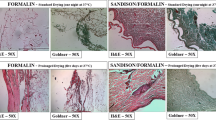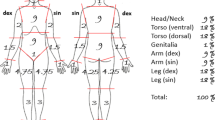Abstract
Mummified and corified bodies are particularly complex scenarios to investigate, starting from identifying the post-mortem interval (PMI), even more so in indoor environments. In these bodies, the skin has the peculiar feature to resist for a long time. Among its components, there are elastic fibers, which are characterized by intrinsic resistance to post-mortem degenerative phenomena. Starting from these considerations, we investigated microscopically the persistence, detectability, and changes of elastic fibers in the skin of mummified and corified bodies with different known PMI. The aim was to evaluate whether they could provide an additional tool to aid in PMI estimation in these cases. Therefore, we collected skin samples from mummified or corified bodies found in a domestic environment with different known PMI, as well as from corified bodies that had been exhumed after 11 years of burial. Histochemical staining specific for elastic fibers, namely, Weigert’s resorcin fuchsin, showed their prolonged persistence and a progressive and different degradation between mummified and corified skin as a function of PMI. Moreover, on the whole, we observed greater preservation of elastic fibers in mummified skin than in corified one at the same PMI. Therefore, histological analysis of elastic fibers in mummified and corified skin may help to provide valuable aid in estimating PMI, especially in those particular cases where more reliable alternatives are lacking.









Similar content being viewed by others
Data availability
All the data have been reported in the manuscript.
Code availability (software application or custom code)
Not applicable.
References
Giusti G (1998) Trattato di Medicina Legale. CEDAM, Padova
Panzer S, Zink AR, Piombino-Mascali D (2010) Scenes from the past: radiologic evidence of anthropogenic mummification in the capuchin catacombs of Palermo, Sicily. Radiographics 30:1123–1132. https://doi.org/10.1148/rg.304095174
Fornes P, Tovaglia P, Cecchi R (2007) Il contributo dell’istopatologia nello studio del cadavere putrefatto. Zacchia Arch Med Leg Soc Criminol 80:531–541
Cazzaniga A, Cattabeni CM, Luvoni R, Zoja R (2018) La morte e i fenomeni cadaverici. In: A. Cazzaniga, C.M. Cattabeni, R. Luvoni, R. Zoja R (eds) Compendio di Medicina Legale e delle Assicurazioni, 14th edn. UTET Giuridica, Torino, p 309–333
Carrasco PA, Brizuela CI, Rodriguez IA, Muñoz S, Godoy ME, Inostroza C (2017) Histological transformations of the dental pulp as possible indicator of post mortem interval: a pilot study. Forensic Sci Int 279(279):251–257. https://doi.org/10.1016/j.forsciint.2017.09.001
Tozzo P, Scrivano S, Sanavio M, Caenazzo L (2020) The Role of DNA degradation in the estimation of post-mortem interval: A systematic review of the current literature. Int J Mol Sci 21:3540. https://doi.org/10.3390/ijms21103540
Bauer M, Gramlich I, Polzin S, Patzelt D (2003) Quantification of mRNA degradation as possible indicator of postmortem interval-a pilot study. Leg Med 5(4):220–227. https://doi.org/10.1016/j.legalmed.2003.08.001
Donaldson AE, Lamont IL (2013) Biochemistry changes that occur after death: potential markers for determining post-mortem interval. PLoS ONE 8(11):e82011. https://doi.org/10.1371/journal.pone.0082011
Jiang Z, You M, Wang X, Lu D, Zhang H, Di S, Zhang F, Guo Z, Xiaofei L, Chang J, Xiang R, Bai T. Yang (2016) Estimation of the postmortem interval by measuring blood oxidation–reduction potential values. J Forensic Sci Med 2:8. https://doi.org/10.4103/2349-5014.155727
Bohra B, Verma R, Mathur IB, Sharma Y, Khangwal VP, Joshi M (2014) Estimation of postmortem interval by measuring potassium level in vitreous humour. J Indian Acad Forensic Med 36:374–378
Guo J, Fu X, Liao H, Hu Z, Long L, Yan W, Ding Y, Zha L, Guo Y, Yan J, Chang Y, Cai J (2016) Potential use of bacterial community succession for estimating post-mortem interval as revealed by high-throughput sequencing. Sci Rep 6:24197. https://doi.org/10.1038/srep24197
Sharma R, Garg RK, Gaur JR (2015) Various methods for the estimation of the post mortem interval from Calliphoridae: a review, Egypt. J Forensic Sci 5:1–12. https://doi.org/10.1016/j.ejfs.2013.04.002
Caccianiga M, Caccia G, Mazzarelli D, Salsarola D, Poppa P, Gaudio D, Cappella A, Franceschetti L, Tambuzzi S, Maggioni L, Cattaneo C (2021) Common and much less common scenarios in which botany is crucial for forensic pathologist and anthropologists: a series of eight case studies. Int J Legal Med 135:1067–1077. https://doi.org/10.1007/s00414-020-02456-0
Ceciliason AS, Andersson MG, Lindström A, Sandler H (2018) Quantifying human decomposition in an indoor setting and implications for postmortem interval estimation. Forensic Sci Int 283:180–189. https://doi.org/10.1016/j.forsciint.2017.12.026
Ceciliason AS, Andersson MG, Nyberg S, Sandler H (2021) Histological quantification of decomposed human livers: a potential aid for estimation of the post-mortem interval? Int J Legal Med 135:253–267. https://doi.org/10.1007/s00414-020-02467-x
Vass AA, Bass WM, Wolt JD, Foss JE, Ammons JT (1992) Time since death determinations of human cadavers using soil solution. J Forensic Sci 37:1236–1253
Megyesi MS, Nawrocki SP, Haskell NH (2005) Using accumulated degree days to estimate the postmortem interval from decomposed human remains. J Forensic Sci 50:618–626
Teo CH, Hing HL, Hamzah NH, Hamzah SPAA (2021) The effect of different coverings on total body score development of buried carcasses. Malays J Med Sci 28:103–112. https://doi.org/10.21315/mjms2021.28.4.11
Collini F, Andreola SA, Gentile G, Marchesi M, Muccino E, Zoja R (2014) Preservation of histological structure of cells in human skin presenting mummification and corification processes by Sandison’s rehydrating solution. Forensic Sci Int 244:207–212. https://doi.org/10.1016/j.forsciint.2014.08.025
Gentile G, Andreola S, Bilardo G, Boracchi M, Tambuzzi S, Zoja R (2020) Technical note-stabilization of cadaveric corified and mummified skin thanks to prolonged temperature. Int J Legal Med 134:177–1801. https://doi.org/10.1007/s00414-020-02258-4
Bardale RV, Tumram NK, Dixit PG, Deshmukh AY (2012) Evaluation of histologic changes of the skin in postmortem period. Am J Forensic Med Pathol 33:357–361. https://doi.org/10.1097/PAF.0b013e31822c8f21
Cingolani M, Osculati A, Tombolini A, Tagliabracci A, Ghimenton C, Ferrara SD (1994) Morphology of sweat glands in determining time of death. Int J Legal Med 107:132–140. https://doi.org/10.1007/BF01225600
Kovarik C, Stewart D, Cockerell C (2005) Gross and histologic postmortem changes of the skin. Am J Forensic Med Pathol 26:305–308. https://doi.org/10.1097/01.paf.0000188087.18273.d2
Jellinghaus K, Urban PK, Hachmann C, Bohnert M, Hotz G, Rosendahl W, Wittwer-Backofen U (2019) Collagen degradation as a possibility to determine the post-mortem interval (PMI) of human bones in a forensic context - a survey. Leg Med (Tokyo) 36:96–102. https://doi.org/10.1016/j.legalmed.2018.11.009
Bailo P, Andreola S, Collini F, Gentile G, Maciocco F, Piccinini A, Zoja R (2021) Histomorphological aspects of cadaveric skin and its possible use in forensic genetics. Med Sci Law 61:46–53. https://doi.org/10.1177/0025802420934662
Ross R (1973) The elastic fiber. J Histochem Cytochem 21:199–208. https://doi.org/10.1177/21.3.199
Uitto J, Li Q, Urban Z (2013) The complexity of elastic fibre biogenesis in the skin–a perspective to the clinical heterogeneity of cutis laxa. Exp Dermatol 22:88–92. https://doi.org/10.1111/exd.12025
Butzelaar L, Niessen FB, Talhout W, Schooneman DPM, Ulrich MM, Beelen RHJ, Mink van der Molen AB (2017) Different properties of skin of different body sites: the root of keloid formation? Wound Repair Regen 25:758–766. https://doi.org/10.1111/wrr.12574
Parish WE (1985) Cutaneous elastin degradation in ageing and inflammation. J Appl Cosmetol 3:187–210
Waslen GD (1986) Management of outpatient burns. Can Fam Physician 32:805–808
Decreto del Presidente della Repubblica. Regolamento di Polizia Mortuaria, DPR n. 285, 10 settembre 1990
Boracchi M, Andreola S, Gentile G, Maghin F, Marchesi M, Muccino M, Zoja R (2016) Technical note: Improvement of cadaveric skin samples (with severe morphological alteration connected to putrefaction or injury) by an extended histological processing. Forensic Sci Int 261:101–105. https://doi.org/10.1016/j.forsciint.2016.02.015
AFIP-Armed Forces Instutute of Pathology (1992) Laboratory methods in histotechnology. American Registry of Pathology, Washington, DC
Maghin F, Andreola SA, Boracchi M, Gentile G, Maciocco F, Muccino E, Zoja R (2018) Technical note: a histochemical approach in diagnosing hanging mechanical asphyxia on cadavers undergoing advanced putrefactive phenomena. Med Leg J 86:208–213. https://doi.org/10.1177/0025817218764754
Gentile G, Battistini A, Andreola S, Boracchi M, Marchesi M, Tambuzzi S, Zoja R (2020) Technical note: preparation improvement of charred cadaveric viscera using Sandison’s rehydrating solution for histological analysis. Forensic Sci Int 306:110066. https://doi.org/10.1016/j.forsciint.2019.110066
Tambuzzi S, Gentile G, Bilardo G, Boracchi M, Bailo P, Casalino T, Andreola S, Zoja R (2022) Technical note: a comparison between rehydrating solutions in the pretreatment of mummified and corified skin for forensic microscopic examination. Int J Legal Med 136:997–1007. https://doi.org/10.1007/s00414-022-02833-x
Lu QL (1999) Study of elastic fiber changes of human skin in distinction between antemortem and postmortem wounds. Fa Yi Xue Za Zhi. 15(1):7–8, 62. Chinese
Fatteh A (1971) Distinction between antemortem and postmortem wounds: a study of elastic fibers in human skin. J Forensic Sci 16:393–396
Pasquali-Ronchetti I, Baccarani-Contri M (1997) Elastic fiber during development and aging. Microsc Res Tech 38:428–435. https://doi.org/10.1002/(SICI)1097-0029(19970815)38:4%3c428::AID-JEMT10%3e3.0.CO;2-L
Kazlouskaya V, Malhotra S, Lambe J, Idriss MH, Elston D, Andres C (2013) The utility of elastic Verhoeff-Van Gieson staining in dermatopathology. J Cutan Pathol 40:211–225. https://doi.org/10.1111/cup.12036
Rinn JL, Wang JK, Liu H, Montgomery K, van de Rijn M, Chang HY (2008) A systems biology approach to anatomic diversity of skin. J Invest Dermatol 128:776–782. https://doi.org/10.1038/sj.jid.5700986
Langton AK, Alessi S, Hann M, Chien AL, Kang S, Griffiths CEM, Watson REB (2019) Aging in skin of color: disruption to elastic fiber organization is detrimental to skin’s biomechanical function. J Invest Dermatol 139:779–788. https://doi.org/10.1016/j.jid.2018.10.026
Halushka MK, Angelini A, Bartoloni G, Basso C, Batoroeva L, Bruneval P, Buja LM, Butany J, d’Amati G, Fallon JT et al (2016) Consensus statement on surgical pathology of the aorta from the Society for Cardiovascular Pathology and the Association For European Cardiovascular Pathology: II. Noninflammatory degenerative diseases - nomenclature and diagnostic criteria. Cardiovasc Pathol 25:247–257. https://doi.org/10.1016/j.carpath.2016.03.002
Baumann L (2007) Skin ageing and its treatment. J Pathol 211:241–251. https://doi.org/10.1002/path.2098
Robert L, Jacob MP, Frances C, Godeau G, Hornebeck W (1984) Interaction between elastin and elastases and its role in the aging of the arterial wall, skin and other connective tissues A review. Mech Aging Dev 28:155–166. https://doi.org/10.1016/0047-6374(84)90015-0
Madea B, Ortmann J, Doberentz E (2019) Estimation of the time since death-even methods with a low precision may be helpful in forensic casework. Forensic Sci Int 302:109879. https://doi.org/10.1016/j.forsciint.2019.109879
Author information
Authors and Affiliations
Contributions
TS and GG equally contributed to this work: writing–original draft, writing–review and editing, conceptualization, investigation, methodology, data curation. AS contributed to investigation and methodology. BG, CF, and BP contributed to samples collection, literature research, and editing. RZ guarantor of the project and directed the study, devised the main conceptual idea of the article.
Corresponding author
Ethics declarations
Ethics approval
The collection, manipulation, and forensic analysis of skin samples were performed under Italian law since the subjects involved in this pilot study underwent a judicial autopsy at the Institute of Forensic Medicine in Milan in order to determine the cause of death. Therefore, all the lab analyses were authorized by the prosecutor. As for the exhumed bodies that were not subjected to a judicial autopsy, skin sample collection was approved by the Health Authority and took place under the Mortuary Police Regulations (Presidential Decree 285, September 10, 1990) [29]. Therefore, ethical approval is not required in these cases; however, the subjects' anonymity must be guaranteed.
Consent to participate
The authors declared that all the investigations were carried out accordingly to the Italian law.
Consent for publication
All the authors agree for publication.
Conflict of interest
The authors declare no competing interests.
Additional information
Publisher's note
Springer Nature remains neutral with regard to jurisdictional claims in published maps and institutional affiliations.
Stefano Tambuzzi and Guendalina Gentile are co-first authors.
Highlights
1. Degradation of elastic fibers in mummified and corified bodies is PMI-related.
2. Elastic fibers are more preserved in mummified skin than coriefid skin.
3. Elastic fibers in mummified and corified may help for PMI estimation in indoor settings.
Rights and permissions
Springer Nature or its licensor (e.g. a society or other partner) holds exclusive rights to this article under a publishing agreement with the author(s) or other rightsholder(s); author self-archiving of the accepted manuscript version of this article is solely governed by the terms of such publishing agreement and applicable law.
About this article
Cite this article
Tambuzzi, S., Gentile, G., Andreola, S. et al. Elastic fiber degradation as a possible indicator for PMI estimation on mummified and corified skin: a pilot study. Int J Legal Med 137, 519–535 (2023). https://doi.org/10.1007/s00414-022-02915-w
Received:
Accepted:
Published:
Issue Date:
DOI: https://doi.org/10.1007/s00414-022-02915-w




